If you asked me to look back at my home library experiment so far and identify the one area of children’s literature where I really feel like I dropped the ball, the one area in which I feel that our library has the worst overall coverage, I already know the answer. NURSERY RHYMES. I have completely, completely failed to give my daughter a proper education in nursery rhymes. Why? I’m not totally sure. We have some nice nursery rhyme and Mother Goose collections at home, including a particularly cool one – My Very First Mother Goose – that’s edited by Iona Opie with illustrations by Rosemary Wells (I’d definitely recommend it), but, for whatever reason, we haven’t really read any of them all that much.
I’m not quite sure where my unconscious prejudice against nursery rhymes comes from. Maybe I felt that we had enough sing-songy-type picture books, books that we recited and sang so often that it made up for our lack of reading “Humpty Dumpty” or “Three Blind Mice.” (We used to recite Bill Martin and Eric Carle’s Brown Bear, Brown Bear, What Do You See? on our drive to daycare every morning.) Maybe, as guy who used to edit reference books on children’s literature, I’d read way, way too many academic essays on the historical origins of nursery rhymes and I got it into my head that I didn’t want to have to explain to my kid the socio-political subtext of “stuck a feather in his hat and called it Macaroni.” Maybe I was turned off by the sepia-toned, English nursery illustrations in so many of the Mother Goose collections – with the girls in big frilly dresses and the obscenely cute anthropomorphized animals being so freaking precious all the time. I don’t really know.
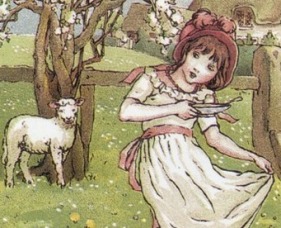
I know Kate Greenaway is a legend of children's illustration, but these dainty, precious nursery rhyme images always turn me off.
In retrospect, it seems so odd to me. Before she was born, I was obsessed with making sure that my daughter had a strong library of fairy tales and folklore. As I’ve mentioned on the blog previously, I made sure that she had to have a “Dad approved” version of Cinderella, Snow White, The Little Red Hen, and so on, even if only so she’d be able to get all the various references to “classic fairy tales” that populate so many modern picture books. (How could she understand the genius of The Stinky Cheese Man if she’d never read The Gingerbread Man first?) But, for frankly stupid reasons, it apparently never occurred to me to make sure that she had the same education in nursery rhymes. Sure, I did buy a few nursery rhyme collections, but I never really pulled them out all that often. And I have no idea why. (Is “nursery rhyme prejudice” a recognized mental disorder?)
To be honest, my daughter got most of her education in nursery rhymes from a “Songs for Kids” CD that my mother bought to play in the car whenever she picked up my daughter for a play-date or sleep-over. While, at first, I found the CD a little obnoxious, it eventually won me over. I hadn’t really thought about how my daughter would eventually learn about “classic” children’s songs like “She’ll Be Coming ‘Round the Mountain” or “Pop Goes the Weasel,” but the CD in Grandma’s car actually did a fantastic job of making her fall in love with a nice mixture of old songs and nursery rhymes set to music. The first time I heard my daughter singing “Ba Ba Black Sheep” to herself – with full knowledge that neither I nor my wife had taught her the song – was both a weird and really wonderful moment.
This long preamble is my way of telling you that I really, really didn’t expect my daughter to like Nursery Rhyme Comics, a 2011 collection of “50 timeless rhymes from 50 celebrated cartoonists”, edited by Chris Duffy. Now that my daughter is five, I thought the window for her enjoying nursery rhymes had passed. I thought that, thanks to my nursery negligence, the rhymes would just be too “baby” and uninteresting for her. And, when we took it out from the library, I was very aware that I was more taking it out for me than for her. I’m a big comics fan and some of my very favorite artists – Scott Campbell, Kate Beaton, Jaime Hernandez, Jules Feiffer, Gene Luen Yang, Tao Nyeu, Tony Millionaire, and more – had contributed to the anthology, so, personally, I just really wanted to read it. I didn’t actually think that my daughter would care that much about it.
Now, long-time readers of my blog can feel me building up to something here. And what I’m building up to is the reveal of the ONE seemingly constant and unchangeable rule of parenting that I never seem to be able to escape. A rule that I’ve referenced over and over again in my book reviews. What’s that rule? The fact that – when I make a parental decision or even when I speak a particularly declarative sentence – I am almost always, always WRONG.
My daughter was intrigued when I checked out Nursery Rhyme Comics from the library and asked me to read her a few of the rhymes at bedtime. I said we’d read five rhymes, expecting that her interest would quickly wane and we’d move onto something else. But we did not read five rhymes that night. We read ALL FIFTY rhymes. TWICE. I was completely unprepared for the sheer, unbridled JOY that Nursery Rhyme Comics brought to my five-year-old. She went NUTS for it. She LOVED it.
Do you want to know how much she loved it? The next day, after I had to read her the whole anthology AGAIN, she asked me, “Do you think Santa will bring me this book for Christmas if I ask him?” For those of you without kids, just FYI, that’s maybe the single greatest endorsement ANY kids’ book can EVER have. That’s like a movie winning 12 Oscars and making a billion dollars at the box office.
Suffice to say, Nursery Rhyme Comics was a HUGE hit. My daughter loved the mixture of the familiar – standards like “Humpty Dumpty”, “Jack and Jill”, and “Mary Had a Little Lamb” – and the unfamiliar – rhymes like “Solomon Grundy”, “My Name is Yon Yonson”, and “The Grand Old Duke of York”. She adored the rhythm of the short verses and sung along when she could. She giggled with delight when she recognized the artistic style of an illustrator she was familiar with – she recognized Scott Campbell from Zombie in Love, Roz Chast from Steve Martin’s The Alphabet from A to Y With Bonus Letter Z, and Mike Mignola from “Daddy’s Hellboy comics” (which will now be kept on a higher shelf).
She particularly enjoyed all of the comic touches and embellishments that each artist brought to their selected rhymes. James Sturm‘s “Jack Be Nimble” stands out as an example. As the rhyme goes on, Jack talks directly to the reader, informing us that “I don’t even know what nimble means” and eventually scolding us for putting the idea of jumping over a candlestick into a kid’s head. (The big punchline – which made my daughter choke with laughter – was that, after yelling at us for making such a suggestion, Jack turns to walk away, only to reveal his partially-singed rear end.)
And all those issues that, in the past, had bothered me about reading nursery rhymes – they never came up. While reading Nursery Rhyme Comics, my daughter never asked me to explain who “The Grand Old Duke of York” really was. She never asked me to explain what exactly was the deal with “The Owl and the Pussycat”. She never asked me to justify the somewhat off-rhyme scheme in “Hector Protector”, she never got caught up by a piece of dated or anachronistic language, and she never got upset by any of the gruesome details, even when Solomon Grundy died on Saturday. She just enjoyed them. She enjoyed the words, the pictures, the rhythms – she just found the whole anthology to be a great deal of fun. And I’m so wonderfully surprised and gobsmacked by that revelation.
I feel like an idiot saying this, but it’s now become clearly apparent to me why there are so many collections and anthologies of these particular nursery rhymes. It’s because they’re good. They’re very good and, even if they’re dated or don’t exactly rhyme perfectly or don’t make much sense, the very fact that they’ve persisted and endured for SO many years is a testament to their quality. I might not be able to explain exactly why a child should enjoy “Old Mother Hubbard” or “The Owl and the Pussycat”, but that doesn’t matter. These rhymes have been market-tested in front of GENERATIONS of children who have fully embraced and adored them, so, the fact that I, as a dad, might not be able to get my thick head completely around “Wee Willy Winkie” means nothing. There are times when you just need to remove yourself from the equation, stop over-analyzing every little detail, and just enjoy the moment. (I completely realize the irony of me using 2,000+ words to tell other people to “stop over-analyzing” things. I am a man of many contradictions.)
And nursery rhymes are wonderful vehicles for teaching kids to enjoy short, vivid moments of wordplay and imagery. I totally see that now. In retrospect, I regret not properly exposing my daughter to nursery rhymes earlier, but I’m heartened that, thanks to Nursery Rhyme Comics, I now know that she isn’t too old to enjoy sitting and reading “Old King Cole” with her father – if the version is as compelling and well-told as the verses in this extremely cool comic anthology.
THE DETAILS ON NURSERY RHYME COMICS:
AGE RANGE: The stated age range is 3 and up. However, these are essentially the same nursery rhymes that you can find in a lot of Mother Goose collections, so you could definitely read it to a younger audience. The only possible issue I might be able to see is, while the subject matter is definitely age-appropriate for 3 and under, the format of the retellings are so sophisticated in some cases – in terms of graphic design, layout, and text size – that some of the rhymes might be hard for younger readers to engage with and follow. But, if you’ve got a great reader taking them through the rhymes, I wouldn’t anticipate many problems.
PAGE COUNT: 120 pages
RELATED WEB SITES: Nursery Rhyme Comics is published by First Second Books, a division of Macmillan. You can find the official Macmillan Nursery Rhyme Comics page here – it has some basic info on the book and a really nice slideshow of some of the illustrated rhymes.
BUY IT, BORROW IT, OR FORGET IT?: We took it out from the library and I’m glad we did. My daughter is a big comic book fan, so I don’t know if that’s one of the reasons she responded so positively to the format of Nursery Rhyme Comics. HOWEVER, since she asked if Santa would buy her the book (such high praise)… yeah, we’re totally buying it for her.
IF YOU LIKED NURSERY RHYME COMICS, YOU MIGHT ALSO LIKE:
- The Little Lit series, edited by Art Spiegelman and Françoise Mouly – I wrote a brief post last year on the Little Lit series and, while they skew older than Nursery Rhyme Comics, these kid-focused comic anthologies definitely share some of the same DNA as Chris Duffy’s nursery rhyme collection. There have been three volumes so far – Folklore & Fairy Tale Funnies, Strange Stories for Strange Kids, and It Was a Dark and Silly Night – and one collected volume of the whole series so far called Big Fat Little Lit. Each volume has attracted a murderer’s row of amazing writers and illustrators as contributors – people like David Sedaris, Ian Falconer, Maurice Sendak, Crockett Johnson, Chris Ware, Charles Burns, Daniel Clowes, Jules Feiffer, Neil Gaiman, William Joyce, Lewis Trondheim, Lemony Snicket, Spiegelman himself, and lots, lots more. These are very smart, very engaging comics for kids.
- My Very First Mother Goose, edited by Iona Opie, illustrated by Rosemary Wells – This is the collection I mentioned earlier – the fantastic nursery rhyme volume that I almost never read to my daughter. Again, all of the blame for that decision should reflect poorly on me and not on this book, because this is an extremely well done, beautiful composed edition of nursery rhymes for kids. The big format of the volume – big pages, big figures, big text – is PERFECT for the youngest readers to browse through, and Wells’ illustrations escape all of the nursery rhyme traps that I complained about earlier (i.e. frilly dresses, tea parties, and overdone Victorian cuteness). Wells’ artwork is so gorgeous and clever that you’ll want to frame every page.
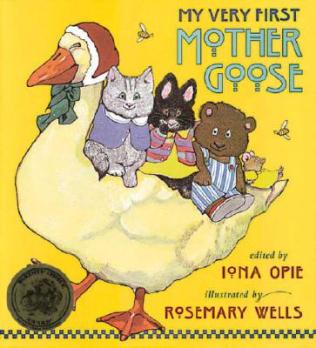
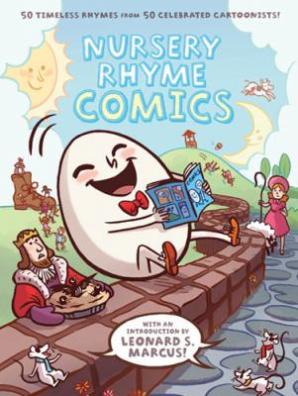
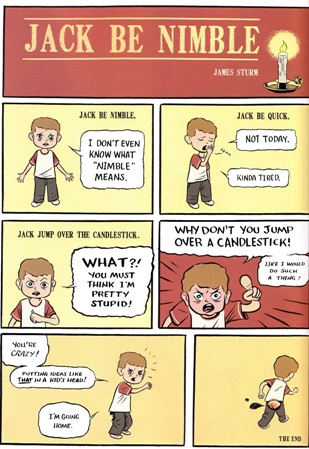
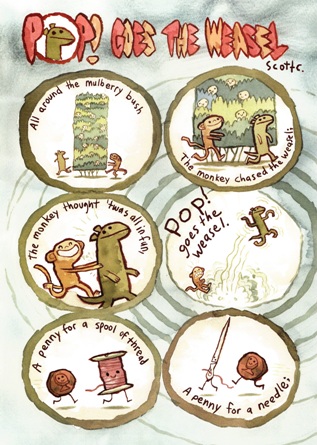
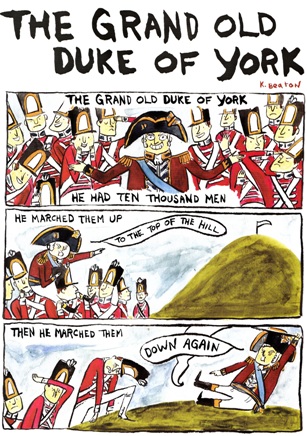
{ 5 comments… read them below or add one }
I got my son this book when he was 2, after checking it out the library 3 times in a row, and he tried to cuddle it for a week straight while he slept.
Ooh, comic book nursery rhymes! Something to add to my list of must- haves!
I love this book. So what exactly is the deal with the owl and the pussycat?
Owl and the Pussycat is an odd rhyme because a). it’s just weird, in that grand tradition of English-nonsense-weird and b). it calls for the reader to frequently use a shortened version of the word “pussycat,” which, as a dad reading to his young daughter, feels very off-putting and inappropriate – even though I TOTALLY understand the context and connotation of the word.
Other than a Ladybird book I had at about age 4, I don’t remember reading many nursery rhymes or having them read to me by my parents. My grandmother had a quilt with some of the major characters on it and she would point to them and tell me the rhyme when she tucked me in. The rest I heard from kids’ records and tapes and by general osmosis. At that age so little of what you hear makes much sense, so nursery rhymes don’t seem particularly odd until you get older and realize what the words mean.
You must log in to post a comment.